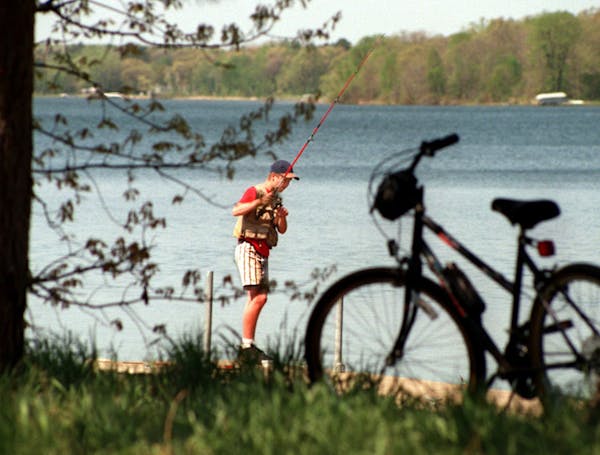Reports last week citing the aggregation of as many as 900,000 ring-necked ducks at Rice Lake National Wildlife Refuge had radar watchers all atwitter, including those at the National Weather Service in Duluth. But conflating this interesting but not unexpected phenomenon with Minnesota's, and the continent's, otherwise relatively anemic duck populations would be a mistake.
I say this knowing most state and federal waterfowl managers, upon reading the last sentence will 1) immediately assume the head-buried-in-the-sand crouch long familiar to those in perpetual denial, and 2) nearly as immediately log on to their laptops to seek the comfort of their co-conspirator brethren (and they are mostly men).
Ringnecks first: The U.S. Fish and Wildlife Service, to the degree its counting methodology can be trusted, eyeballed 693,500 breeding ringnecks during this spring's continental survey, a figure similar to past counts.
Meaning if the folks at Rice Lake were correct in their assessment on Thursday of some 900,000 ringnecks on site (including young of the year), most of that breed's continental population were present on the 18,000-acre sanctuary — again, an interesting but not unheard of occurrence, because these ducks typically migrate through Minnesota.
However, to infer from it that the continent's ducks are in good shape, or that duck management in this nation is on track, would be wrong.
Consider, for example, Minnesota hunting regulations initiated in 2011 while Tom Landwehr was boss at the Department of Natural Resources.
Wanting a bone to toss to waterfowlers who were sick of seeing no birds over their decoys, among other changes Landwehr opened the season earlier — it debuted Sept. 21 this year — while also hiking the hen mallard and wood duck limits and allowing opening-day shooting to begin a half-hour before sunrise.
In essence, the plan was to shoot our way to more ducks.
Albeit quietly, even some of Landwehr's own managers questioned the moves. With the earlier opener and earlier opening-morning shooting time, hunters, they theorized, might kill a greater proportion of the state's breeding mallards than was the case previously, when more of the birds could disperse into their migration routes, where their harvest rates would be lower.
This was a concern especially for mallard hens (whose daily limit went from one to two in 2011) because they often return to the same nesting sites year after year. Minnesota hunters, therefore, under the liberalized harvest regulations, might be killing the state's mallard breeding stock in proportions they hadn't before.
The increased wood duck daily limit from two to three also was problematic, some believed.
Yet Landwehr got what he wanted, at least in the near term. Minnesota's duck harvest rose 19% in 2011 over 2010, with hunters killing 621,000 ducks, 97,000 more than the previous year. And the wood duck harvest jumped from 78,000 to 151,000.
The concern now is whether Minnesota is beginning to reap the "rewards'' of the 2011 regulation changes. How else, some observers say, to explain this year's hugely disappointing Minnesota opener, given its early date, when all duck species, including, especially, blue-winged teal, should have been in the state? Shouldn't the opener, in fact, have been exceptional, given the many brood-friendly downpours and resulting ponds that pockmarked the landscape this spring and summer?
Waterfowl managers, of course, can always explain why ducks are no-shows. "They're over here, not over there.'' "You didn't hunt at the right time.'' "They're staying north.'' "They already flew south.''
Yet wherever a waterfowler travels, whether in Minnesota or in the traditional duck hotbeds of North Dakota, Manitoba and Saskatchewan, the birds aren't there in numbers they once were.
So how can federal waterfowl managers assert that nesting ducks they counted this spring, though down 6% from 2018, were still 10% above the 1955-2018 long-term average?
More remarkable still, the service's count of 41 million ducks in 2018 was more ducks than were tallied from the late 1950s through 1996, during which, if you're old enough to remember, some pretty good duck hunting was had.
Cutting to the chase, regarding Minnesota:
• If the latest rendition of the DNR's duck plan, which is already two months overdue, doesn't call for the expansion of waterfowl refuges and/or resting areas in the state; a rethinking of the date the duck season opens; and an extension of the 4 p.m. hunting closure until at least Oct. 10, you can file the plan under "waste of time.''
• Youth Waterfowl Day — now Youth Waterfowl Weekend — which this year was Sept. 7-8 (when many ducks were barely fledged, or not yet fledged) should be scrapped. Hello, DNR: Fewer Minnesotans hunt ducks every year, and many, if not most, of the die-hards who remain believe, correctly, the kids' day adversely affects the traditional opener. What's more, the youth hunt isn't an effective recruitment tool. Try something else.
• Over-water shooting in the early goose opener also needs to end, again because it disturbs ducks.
Finally, about those ringnecks.
It's at least possible if not likely that if Minnesota returned its duck-season opener to the Saturday nearest Oct. 1, ringnecks migrating through the state would more likely disperse across the northern Minnesota landscape, rather than concentrate as they did last week.
Challenging as this might be to understand, simultaneously, this would make these ducks less vulnerable to disease and more available to hunters, both of which would be good for all involved — except, perhaps, radar watchers.

Anderson: Celebrate Earth Day by rekindling real connection to nature
Anderson: Anglers protesting tough new Mille Lacs rules are wrong

Anderson: Courts, not politicians, should rule on Red Lake, White Earth lands

Anderson: Multimillion windfall gets invasive carp deterrent moving
![A young whitetail deer searches for food as another blanket of snow coats the arrowhead. ] Minnesota -State of Wonders, Arrowhead in Winter BRIAN PETE](https://arc.stimg.co/startribunemedia/WK32UWWY6FKNWJUIYCJ6ZPT4AU.jpg?h=91&w=145&fit=crop&bg=999&crop=faces)

